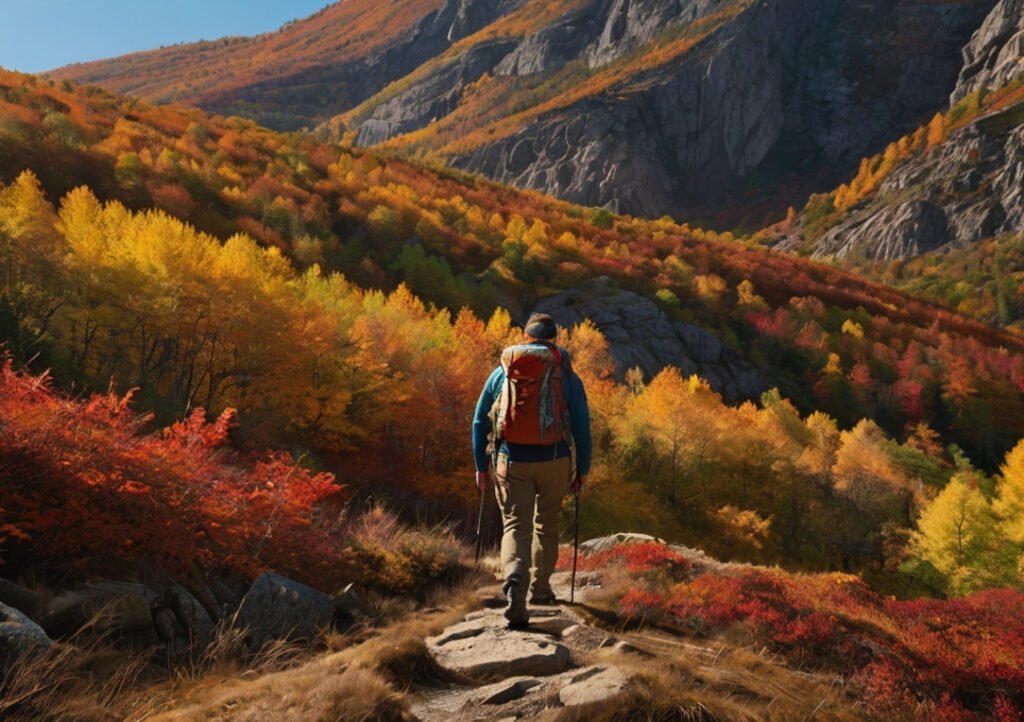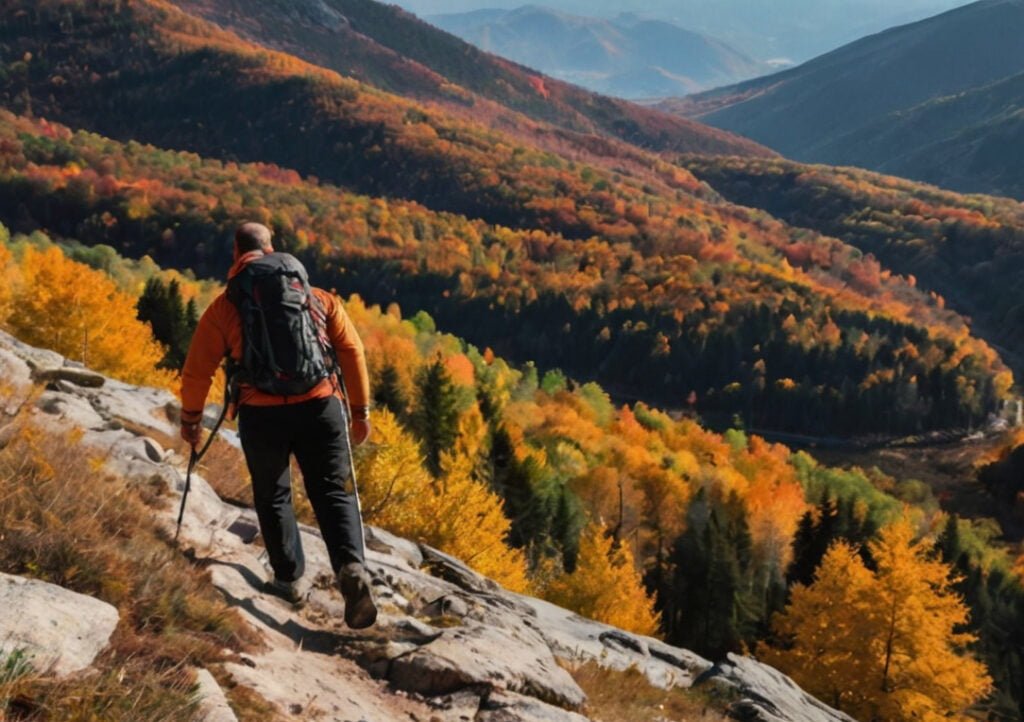Dress in layers and stay hydrated to comfortably hiking in 50 degree weather. Choose moisture-wicking fabrics to maintain body temperature.
Hiking in 50-degree weather offers a refreshing experience with the right preparations. It’s cool enough to enjoy a brisk walk without the intense heat but can quickly feel chilly if you’re not dressed appropriately. Layering is essential; starting with a base layer that wicks away sweat, followed by an insulating layer to retain heat, and topped with a lightweight, breathable jacket.
Remember to wear a hat and gloves if you’re prone to feeling cold. Proper hydration is equally important, as cooler temperatures can sometimes reduce the urge to drink water, leading to dehydration. Keeping these tips in mind ensures a pleasant and safe hiking adventure in mild weather conditions.
What’s Your Favorite Hiking Apparel For Mid 50 Weather?
Layering is key for hiking in 50-degree weather; a breathable fleece paired with a wind-resistant shell provides warmth and versatility. Opt for moisture-wicking fabrics to maintain comfort throughout your trek, ensuring an enjoyable hike in cooler conditions.
Embarking on a hiking adventure in 50-degree weather can be a delight for your senses, provided you’re decked out in the right gear. The crisp air and golden hues of nature beckon the soul, but the enjoyment of the trail hinges on comfortable and suitable attire.
Let’s dive into some indispensable items that should make their way into your backpack or onto your body when the mercury hits that sweet, moderate mark.

The Perfect Layering Combo
Choosing the right combination of layers is essential for maintaining comfort during your hike. Layering allows you to adjust to changing temperatures and conditions as you ascend in elevation or as the day progresses.
- Base Layer: The foundation for warmth and moisture management:
A moisture-wicking base layer keeps your skin dry by drawing sweat away. Opt for materials like merino wool or synthetic fibers, which are known for their quick-drying properties.
- Insulating Layer: The middle layer for trapping body heat:
A fleece or lightweight down jacket serves as an excellent insulator without the bulk. It’s breathable enough to prevent overheating yet provides sufficient warmth.
- Outer Layer: The shield against wind and rain:
A soft-shell or a waterproof, breathable jacket will fend off any unexpected gusts or drips, ensuring that no external dampness spoils your trek.
Essential Accessories For Head-to-toe Comfort
With the body covered, let’s not forget the importance of enclosing extremities in coziness. Even at 50 degrees, fingers and ears can feel the chill, so safeguarding them can make a world of difference on your hiking journey.
- Beanie or Light Hat: Ears’ best friend in the cool weather:
A snug, breathable hat keeps your head warm without causing you to overheat as your pace picks up.
- Gloves: The grip and warmth duo:
Lightweight gloves offer protection against the nip in the air while allowing you the dexterity to navigate your trail essentials.
- Wool or Synthetic Socks: The cornerstone of foot comfort:
Thick enough to cushion, yet designed to prevent swamp-foot, quality socks are non-negotiable. Trust your feet to a pair that offers support and breathability.
- Hiking Boots or Shoes: The critical choice for trail conquest:
The right footwear ensures traction, stability, and lasting comfort as you rack up the miles. Always opt for waterproof materials for those unexpected stream crossings or early morning dew.
Your enjoyable tramp through nature in 50-degree weather hinges on selecting these key pieces of apparel. With attention to warmth without weight, and dryness without sacrifice to comfort, you’ll find yourself admiring the beauty around you rather than fussing with ill-suited gear.
Happy hiking!
What Is The Best Hiking Jacket For Cold Weather?
The ideal hiking jacket for brisk 50-degree weather blends warmth with breathability. Look for lightweight, insulated options that feature water-resistant materials to tackle the chill and potential rain on your trail adventures.
Selecting The Right Material
When the mercury drops and you’re eager to tackle the trails, the fabric of your hiking jacket is your first line of defense against the cold. It’s crucial to understand that not all materials are created equally when it comes to insulation and weather resistance.
- Synthetic Insulation:
Offers excellent warmth-to-weight ratio and retains insulative properties even when wet.
- Down Insulation:
Known for its incredible warmth and compressibility, ideal for dry, cold conditions.
- Softshell and Hardshell:
Softshells provide breathability for active hikes, while hardshells excel in wind and rain protection.
Features To Look For In A Hiking Jacket
A jacket’s functionality can make or break your hiking experience in cooler temperatures. Beyond the basic role of keeping you warm, modern jackets come loaded with features to enhance comfort and convenience on the trail.
- Adjustable Hoods:
Tailored fit around the face and head provides added protection from the wind.
- Ventilation Zippers:
Allow for quick temperature regulation without shedding layers.
- Pockets Placement:
Strategically located for easy access, even with a backpack on.
The Importance Of Layering
The key to staying comfortable during a hike is not just in choosing one good jacket; it’s also about how you layer your clothing. Layering allows for flexibility and adaptation to changing weather conditions and your body’s heat production.
- Base Layer:
Wicks sweat away from the body, keeping you dry and warm.
- Mid Layer:
Provides insulation and retains the heat your body generates.
- Outer Layer:
Shields against the elements, making sure no wind or moisture can penetrate.
Remember, while selecting your cold-weather hiking jacket, it’s not just about the heftiest parka; it’s about combining the right layers to create a personal microclimate that suits your body and the conditions you’ll face on the trail. Tailor your choices to your specific needs, and you’ll find yourself enjoying nature’s chilly embrace with ease and comfort.

What Are The Best Places To Hike In The Us?
Embark on a refreshing hike in the mild embrace of 50-degree weather at Yosemite National Park’s diverse trails. Discover the serene beauty of the Appalachian Trail, a haven for those who relish cooler hikes through panoramic landscapes.
Hiking enthusiasts often find that moderately cool temperatures around 50 degrees Fahrenheit offer the perfect climate for an outdoor adventure. The U. S. Is home to diverse landscapes that thrive in such weather, presenting hikers with a plethora of trails that range from the quiet overturned leaves of forest paths to the majestic heights of mountain peaks.
The Appalachian Trail: A Hiker’s Paradise
The Appalachian Trail is renowned for its rich history and sprawling landscapes that challenge and delight avid hikers. Meandering through 14 states, this trail boasts an array of ecosystems, each providing a unique 50-degree hiking experience. Along the route, the Great Smoky Mountains offer a temperate rainforest climate, while the New England sections provide crisp air and panoramic views.
Pacific Crest Trail: West Coast Wonders
- Scenic diversity: The Pacific Crest Trail (PCT) stretches over 2,650 miles from Mexico to Canada, allowing hikers to experience deserts, forests, and alpine country.
- Moderate climates: Ideal in spring and fall, the PCT’s sections in Oregon and Washington offer the perfect environment for 50-degree weather hikes, with mild days and cool nights.
- Challenging terrains: The Sierra Nevada and Cascades provide more strenuous hikes for those looking to test their skills against the backdrop of 50-degree coolness.
Yellowstone National Park: A Geothermal Gem
Yellowstone’s vibrant geothermal features contrast beautifully with the cooler 50-degree weather, making it a hiker’s dream location. Trails here offer glimpses of geysers, hot springs, and a chance to witness the park’s wildlife in a comfortable and refreshing setting, ensuring every step is as enjoyable as it is awe-inspiring.
Zion National Park: Red Rock Marvels
- Iconic landscapes: Zion’s sandstone cliffs create a breathtaking scene for hikers, with routes like Angels Landing offering stunning vistas.
- Pleasant temperatures: In cooler months, the mercury hovers around the ideal 50-degree mark, perfect for exploring The Narrows or the Watchman Trail without the scorching heat.
- Varied difficulty levels: Whether you’re seeking an easy day hike or an intense trek, these trails offer something for everyone in the cool, inviting weather.
Why Does 50 Degrees Fahrenheit Feel Very Cold In The Fall And Very Comfortable In The Spring?
Hiking in 50-degree weather is all about perception and adaptation. Our bodies adjust to the colder winter temperatures, making 50 degrees feel warmer in spring. Conversely, after the summer heat, the same temperature can feel quite chilly during fall treks.
Understanding Our Body’s Perception Of Temperature
Stepping outside on a brisk 50-degree day in autumn can send a shiver down your spine, yet that same temperature in spring might have you shedding layers. A fascinating aspect of human physiology is how our bodies interpret the same temperature differently depending on the season.
This phenomenon is rooted in our expectations, acclimatization, and the contrasts we experience daily.
Acclimatization To Seasons:
- Gradual Temperature Change: In fall, our bodies are just coming out of summer, when we’re used to warmer temperatures. The sudden drop to 50 degrees feels sharper as a result.
- Anticipation of Cold: During the spring, we gradually emerge from the cold embrace of winter. Hitting that 50-degree mark is a climb from colder days, making it feel almost balmy by comparison.
Contrast Principle In Temperature:
Embracing the contrast principle, our perception is influenced not just by the current temperature but also by the temperature changes we’ve recently experienced. This can make 50 degrees Fahrenheit seem like two different worlds when enjoyed in the fall versus the spring.
- Prior Weather Exposure: Our recent weather experiences heavily influence how we feel current temperatures. If we’ve been dealing with a chilly winter, then 50 degrees in spring is a welcome warmth.
- Adaptation to Climatic Extremes: Post-summer, we’re calibrated to hotter conditions, making the 50-degree weather feel quite brisk as our bodies haven’t readjusted to cooler climes.
The Role Of Clothing And Mindset:
Amidst the colorful leaves of fall, we’re mentally preparing for winter, bundling up and expecting colder days ahead. Contrast this with spring, when we’re eager to cast off the heavy coats in anticipation of summer, 50 degrees thus feels liberating rather than confining.
- Seasonal Wardrobe Changes: The types of clothes we wear in each season affect our perception of the temperature. In fall, lighter wear increases the chill we feel at 50 degrees.
- Psychological Seasonal Adjustment: There’s a psychological aspect to considering 50 degrees as cold or comfortable. In the fall, we mentally brace for winter, and in spring, we’re filled with an eagerness for sunnier skies.
Embracing the chill for an invigorating hike offers a unique adventure. Remember to dress appropriately and stay hydrated. Whether you’re a seasoned trekker or a casual walker, cooler conditions can enhance your experience. So grab your gear and enjoy the trails, no matter the temperature.
Happy hiking!







